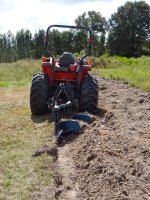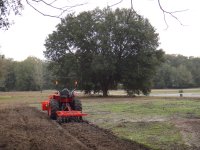I am in southwest Pennsylvania for those who asked. I plan to work approximately 40-50 acres.
In truth I was looking at the old L series tractors, but ground clearance did concern me. Though a lot of the field work i do will be on greens and other root vegetables so I don't have need for a ton of height, a little extra would help to cultivate.
From what I understand, I am looking somewhere in the low-mid 50's for tread width and I need some reasonable weight for the plows at first. I'm looking in the range of 30-50 hp range. Does anyone have any criticism or suggestions of tractors that fit the bill for those requirements?
Take time to enter your SW Pennsylvania location in your T-B-N PROFILE, so your location shows with every post.
I would not want to spend enough time on a Standard L to farm 40 t0 50 acres. Too light, too loud.
I would seek a 1,000 pound heavier, older, Grand L series with HST/Plus and a near flat floor. Much easier to swap implements with great space behind a Grand, relative to a Standard L. Grand L will increase your tractor operating productivity significantly.
You need a tractor with 3,500 pounds to 4,500 pounds bare tractor weight. Every manufacturer has tractors in this weight range.
In mid-50's tread width that would be an
L3560. Older models were /40 series, /30 series and /10 series.
Kubota L3560
2013 - L60 Series
Compact Utility tractor
Previous models: Kubota L3540, L3430, L3410
Series next: Kubota
L4060
Manufacturer: Kubota
Variants:
L3560DT: 4WD
L3560GST: 4WD 12-speed
L3560HST: hydrostatic
L3560HSTC: hydro cab
Kubota
L3560 Engine:
Kubota 1.8L 3-cyl diesel
Kubota
L3560 Power:
Engine (gross): 37 hp [27.6 kW]
Engine (net): 35 hp [26.1 kW]
PTO (claimed): 29.5 hp [22.0 kW] (gear)
28 hp [20.9 kW] (hydro)
Capacity:
Fuel: 13.5 gal [51.1 L]
3-Point Hitch:
Rear Type: I
Control: position control, draft control optional
Rear lift (at 24"/610mm): 2646 lbs [1200 kg]
Power Take-off (PTO):
Rear PTO: independent
Rear RPM: 540 (1.375)
Mid PTO: optional
Mid RPM: 2000
Dimensions & Tires:
Weight: 3483 lbs [1579 kg] (DT ROPS)
3494 lbs [1584 kg] (GST ROPS)
3505 lbs [1589 kg] (hydro ROPS)
3880 lbs [1759 kg] (hydro cab)
Wheelbase: 71.1 inches [180 cm]
Length: 115 inches [292 cm]
Width: 59.8 inches [151 cm] (min)
Height (ROPS): 97.2 inches [246 cm]
Height (cab): 90.6 inches [230 cm]
Ground clearance: 13.5 inches [34 cm]
Rear axle: Flange
Front tread: 45.5 inches [115 cm]
Rear tread:47.2/51.2/54.5/58.3 inches
Mechanical:
Chassis: 4x4 MFWD 4WD
Steering: hydrostatic power
Brakes: wet disc
Cab: Two-post foldable ROPS. Grand Cab with air-conditioning available with hydrostatic.
Hydraulics:
Gear Pump flow: 8.3 gpm [31.4 lpm]
Hydro Pump flow: 8.1 gpm [30.7 lpm]
Gear Total flow: 13.2 gpm [50.0 lpm]
Hydro Total flow: 12.8 gpm [48.4 lpm]
Gear Steering flow: 4.9 gpm [18.5 lpm]
Hydro Steering flow: 4.7 gpm [17.8 lpm]
Electrical:
Ground: negative
Charging system: alternator
ROPS Charging amps: 40
Cab Charging amps: 60
Page information:
Last update: October 20, 2013
Copyright: Copyright 2016 TractorData LLC
Contact:
Peter@TractorData.com

